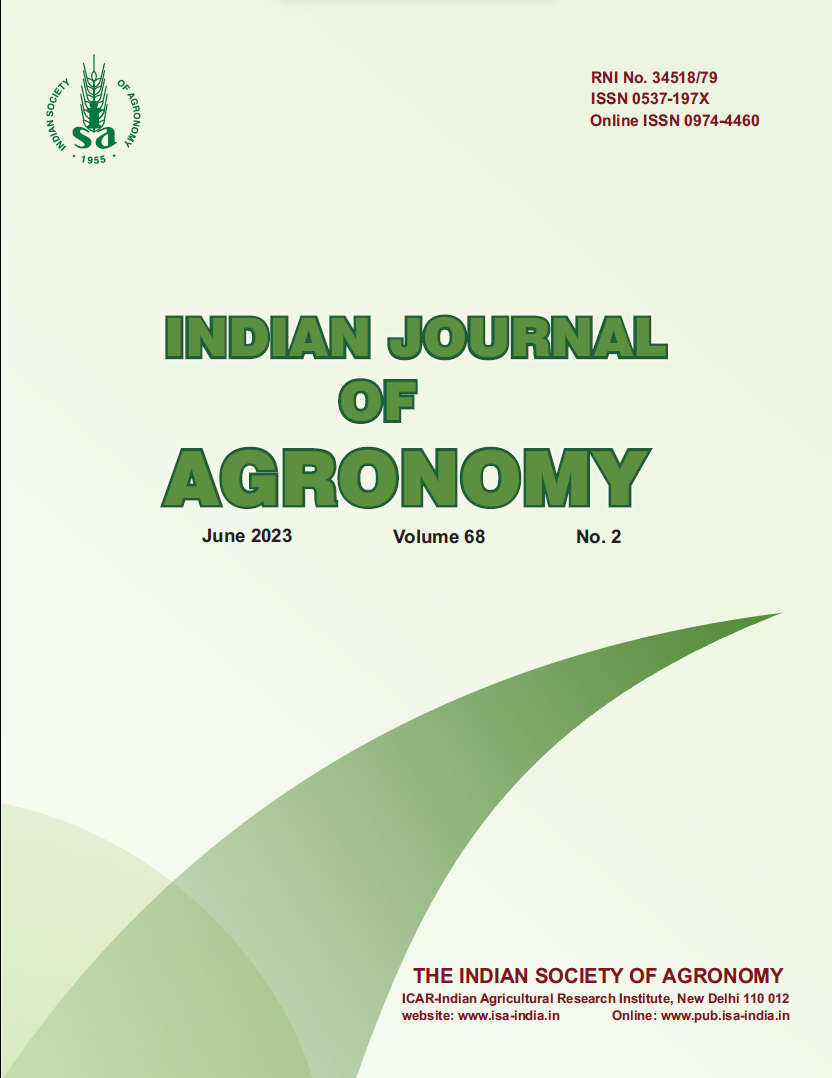Integrated nutrient-management practices effect on productivity of rice (Oryza sativa) and soil properties under rainfed lowland rice situation – A long-term study
DOI:
https://doi.org/10.59797/ija.v68i2.339Keywords:
Green-leaf manures, INM, Inorganic fertilizers, Organic manures, RiceAbstract
An experiment was conducted on a fixed site at Agricultural Research Station (Paddy), Sirsi, University of Agricultural Sciences, Dharwad, Karnataka, India, during the rainy (kharif) season of 2000 to 2017 (18 years), to study the long-term effect of integrated nutrient-management (INM) practices on productivity of rice (Oryza sativa L.) and its soil health. The experiment was laid out in a split-plot design with 7 main plot treatments, viz. no manure, farmyard manure (FYM) @ 10 t/ha, vermicompost @ 5 t/ha, eupatorium @ 10 t/ha, gliricidia [Gliricidia sepium (Jacq.) Steud.] or quick stich @ 10 t/ha, sunhemp (Crotalaria juncea L.) grown in-situ @ 8.96 t/ha and paddy straw @ 5 t/ ha) and 3 subplot treatments [no fertilizer, 50% recommended dose of fertilizer (RDF) and 100% RDF]. The average of 18 years pooled data showed that, the grain yield, straw yield and net returns of rice were significantly higher with the application of gliricidia and eupatorium @ 10 t/ha compared to all other manures. Among the interactions of different organic manures and inorganic fertilizers, combinations of application of gliricidia @ 10 t/ha + 100% RDF resulted in significantly higher grain yield (6.2 t/ha), straw yield (7.8 t/ha) and net returns (`30,569/ha) followed by eupatorium + 100% RDF. The grain yield, straw yield and net returns obtained with application of green-leaf manures, viz. gliricidia alone (5.29, 6.01 t/ha and `25,443/ha, respectively) or eupatorium @ 10 t/ha alone were found to be at par with that of 100% RDF alone.
References
MoA&FW. 2020. Agricultural Statistics at a Glance 2019. Ministry of Agriculture and Farmers Welfare Department of Agriculture, Cooperation and Farmers Welfare, Government of India, New Delhi, p. 48.
Choudhary, A.K., Thakur R.C. and Naveen, K. 2007. Effects of organic manures and chemical fertilizers on productivity and profitability in wheat–rice cropping sequence. ORYZA – An International Journal on Rice 44(3): 239–242.
Harish, Deshpande, H. and Devasenapathy, P. 2011. Effect of different organic sources of nutrients and green manure on growth and yield parameters of rice (Oryza sativa L.) grown under lowland condition. Crop Research 41(1, 2 and 3): 1–5.
Kumaraswamy, K. 1996. Integrated nutrient management techniques vis-a-vis organic farming. (In) Abstracts, National Seminar on Organic farming and Sustainable Agriculture, held during 9–11 October 1996 at the University of Agricultural Sciences, Bangalore, Karnataka, p. 71.
Manjhi, P.R., Mahapatra, P., Shabnam, S. and Yadava, M.S. 2016. Long-term effect of nutrient management practices on performance of quality protein maize under maize (Zea mays)– wheat (Triticum aestivum) cropping sequence. Indian Journal of Agronomy 61(4): 436–442.
Pandey, N., Verma, A.K., Anurag and Tripathi, R.S. 2007. Integrated nutrient management in transplanted hybrid rice. Indian Journal of Agronomy 52(1): 40–42.
Patel, K.P., Thanki, J.D., Patel, D.D., Bafna, A.M., Arvadia, M.K. and Gami, R.C. 2013. Integrated nutrient management in rice (Oryza sativa)–sugarcane (Saccharum officinarum) (plant)– sugarcane (ratoon) cropping sequence. Indian Journal of Agronomy 58(1): 9–14.
Prabhudeva, D.S., Jayaramaiah, R., Manjunatha, M.H., Thimmegowda, M.N. and Kadalli, G.G. 2017. Influence of INM practices with in-situ green manuring on yield and nutrient uptake by potato (Solanum tuberosum L.). Environment and Ecology 35(2C): 1,205–1,212.
Ramesh, P., Panwar, N.R., Singh, A.B. and Ramana, S. 2009. Production potential, nutrient uptake, soil fertility and economics of soybean (Glycine max)-based cropping systems under organic, chemical and integrated nutrient management practices. Indian Journal of Agronomy 54(3): 278–283.
Tripathi, M.K., Majumdar, B., Sarakar, S.K., Chowdhary, H. and Mahapatra, B.S. 2009. Effect of integrated nutrient management on sunnhemp (Crotalaria juncea) and its residual effects on succeeding rice (Oryza sativa) in eastern Uttar Pradesh. Indian Journal of Agricultural Sciences 79(9): 694–698.
Verma, A., Nepalia, V. and Kanthaliya, P.C. 2005. Effect of continuous cropping and fertilization on crop yields and nutrient status of a typic Haplustept. Journal of Indian Society of Soil Science 53: 365–368.
Yadav, S.K., Babu, S., Singh, Y., Yadav, M.K., Pal, S., Singh, R. and Singh, K. 2013. Effect of organic nutrient sources on yield, nutrient uptake and soil biological properties of rice (Oryza sativa)-based cropping sequence. Indian Journal of Agronomy 58(3): 271–276.
Singh, Yadwinder, Khind, C.S. and Singh, Bijay. 1991. Efficient management of leguminous green manures in wetland rice. Advance in Agronomy 45: 135–189.






